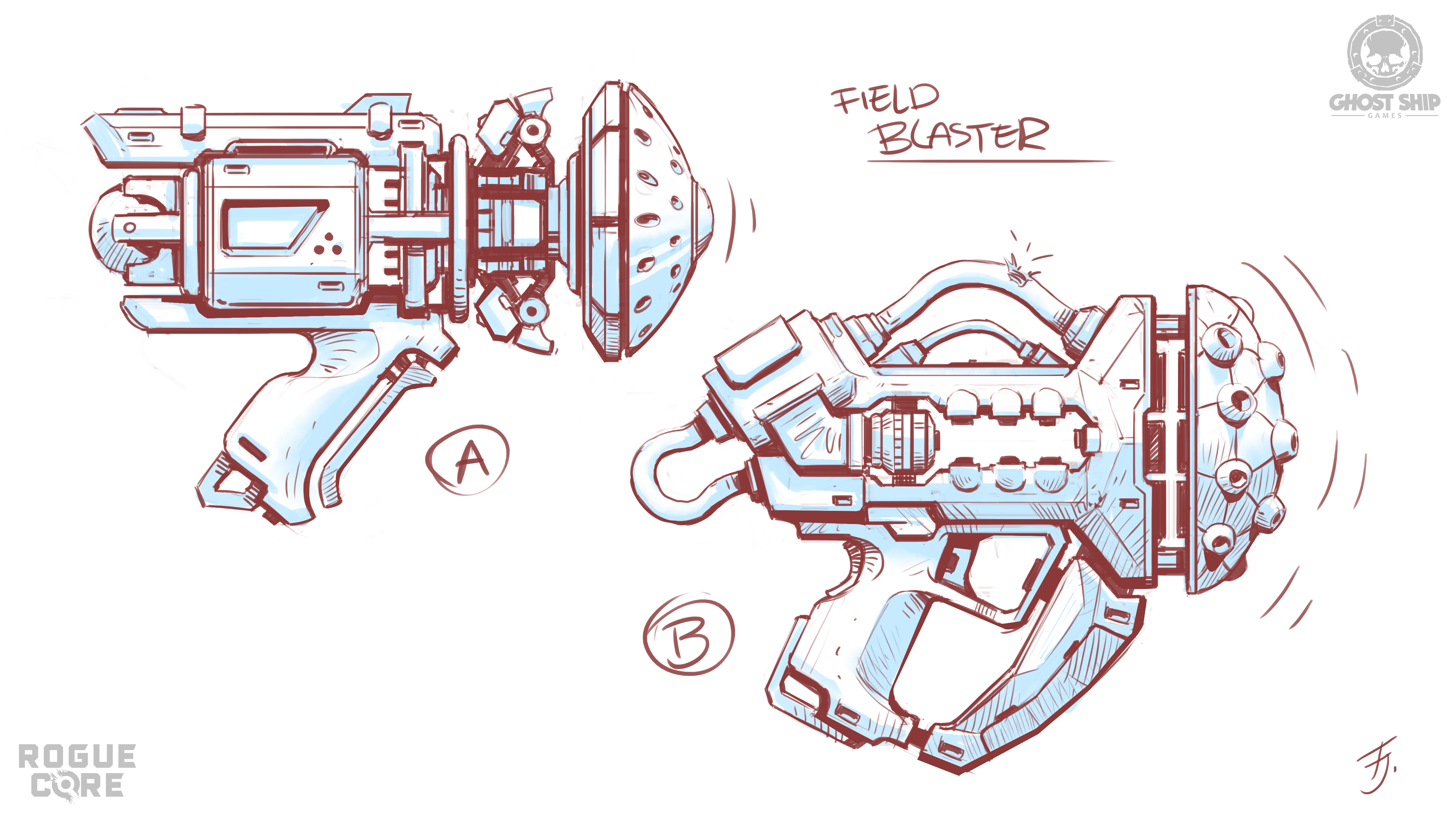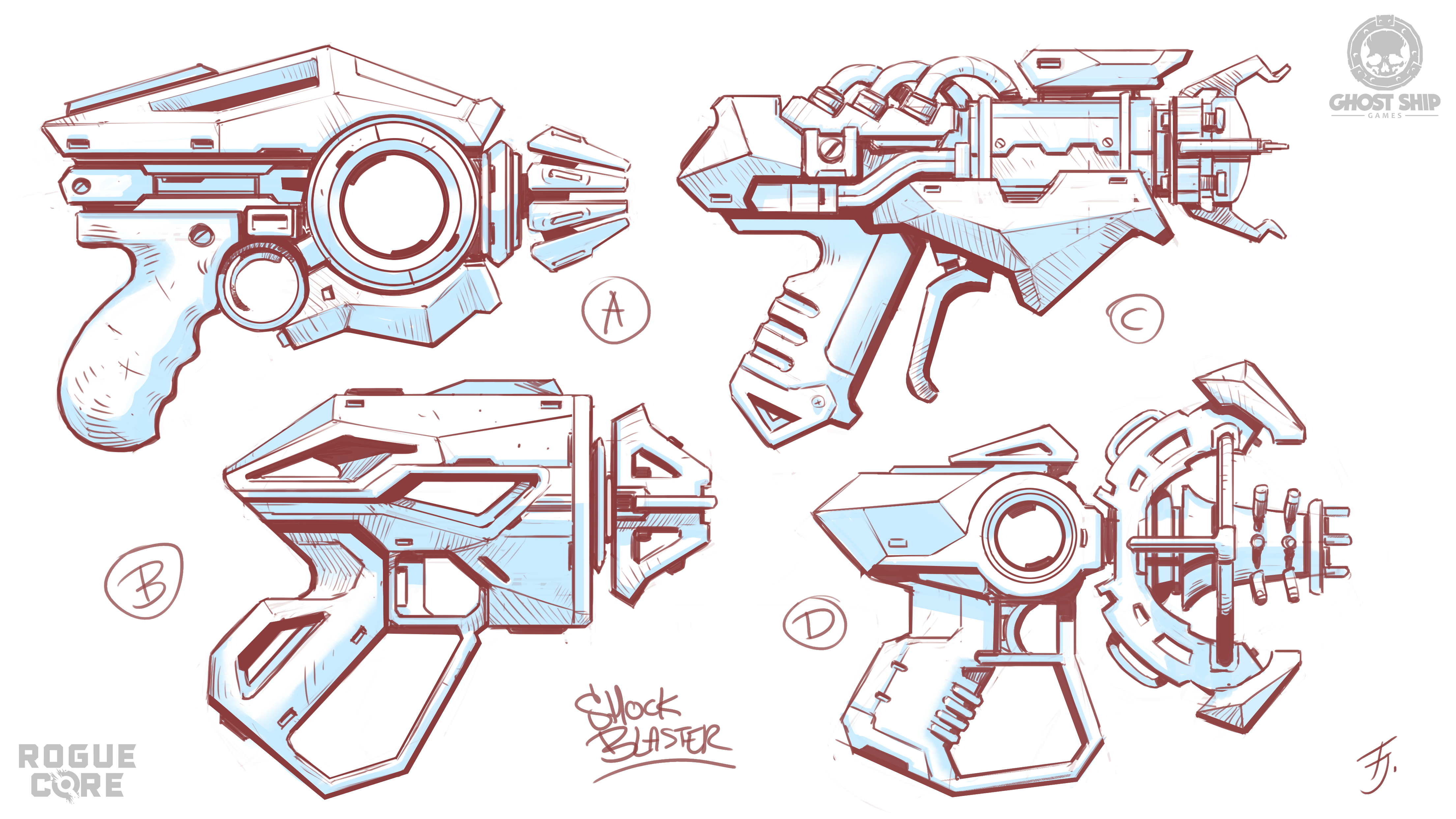There will be more data and proper atribution here (original author, steam link, original post date, etc) real soon, I promise. This is just like a technical test to see if they're coming in ok at all.
Deep Rock Galactic: Rogue Core » Below Decks at Ghost Ship: Drawing guns for Rogue Core

We’ve got some behind-the-scenes stuff to share. Keep in mind that everything below is a work in progress, so we can’t promise that what you’re reading here will make it into the final game.
Having said that, here’s what we’ve been up to lately. 🙂
It’s a Friday morning in October, and Frederik is drawing pictures of pistols.
Frederik Jeppesen is a 3D Artist & Concept Artist at Ghost Ship Games. He’s designed plenty of plants that grow in the caves of Hoxxes, loads of heavy-duty mining equipment, and more weapon frameworks than he can count.
But right now, he’s drafting weapon concepts: a new set of guns for the dwarven Reclaimers, the crack operatives of Deep Rock Galactic: Rogue Core.
Frederik’s seated at his desk, sketching with a stylus on a well-worn black tablet. On his main monitor, he’s got a handful of drafts for a robust, futuristic pistol called a Field Blaster. His second monitor’s got a web browser with tons of tabs open: “Tactical flashlight,” “Man on fire GIF,” “Does tiramisu have alcohol in it.”
There’s also a weathered black replica Colt 1911 handgun resting on his desk, just beside his mouse. “That’s how you know we’re not f**king around here,” he jokes. He picks it up, cocks the hammer and aims it into the distance, taking note of the perspective and how it feels in his hand. “Holding a ‘real’ weapon sort of helps me envision new guns in my mind’s eye, and how the details might look when you’re holding it in the game.”
 Different sketches of the Field Blaster, which fires a wide energy barrier projectile.
Different sketches of the Field Blaster, which fires a wide energy barrier projectile.
In game design, a gun is a medium of communication. It should tell you a bit about itself, even before you pull the trigger.
In that sense, a weapon’s form follows its function. This prototype Field Blaster, for example, shoots a slow-moving energy wave, similar to the Nemesis’ projectiles in Deep Rock Galactic. Frederik’s job is to make sure this gun looks the part.
“Especially with our art style, the shapes are simple and the details are limited. So when I’m designing, I’m aiming for flash comprehension: emphasizing a specific feature that speaks to what the gun does, or how you use it,” he says. “For this one, I’m playing with how to visually communicate a force field emitter, as it doesn’t make sense for this projectile to come from a regular gun barrel. I’m imagining the whole ‘head’ of this gun punching in and out when you fire it, like some sort of pneumatic hammer.”
When designing a new gun, he starts by receiving a pre-prototype from Mike Akopyan, Lead Game Designer. These pre-prototype weapons don’t look special, as they use an existing Deep Rock Galactic gun as a placeholder. But how they function, what they shoot, and how they sound is already completely new by the time they land on Frederik’s desk.
He loads that pre-prototype into a testing engine and plays around with it, to get a feel for how the weapon works and feels. How is it to shoot? What’s the reload like? Is it energy-based, or kinetic? How’s it sound? Does it have a charge-up time?
“Once I play with the gun, I just try to let my mind go blank and start drawing. I really just feel it out. I know it sounds sort of corny, but it’s really just about getting the vibe of the gun,” he says.
 Two concepts for the precise, hard-hitting Charge Blaster.
Two concepts for the precise, hard-hitting Charge Blaster.
Rogue Core’s Reclaimers aren’t miners. They’re the ones you send in when the miners can’t get the job done. Their gear, their presence, and their weapons need to look the part.
“The Deep Rock Galactic miners are industrial guys who are really just going to work. Rogue Core’s Reclaimers are the elite. They’re badass, Solid Snake type of guys. We’ve got to reflect that in their equipment,” Frederik says.
He pulls up a mood board on his monitor, with images he’s using to inspire his designs. The mouse cursor passes over sharp-angled modern battle tanks, blocky boltguns from the Warhammer 40,000 universe, Picatinny rails, plenty of hard edges and rivets. He lingers for a moment on a picture of an F-117 Nighthawk stealth fighter jet.
These sleek, high-tech, elite-operations aesthetics define the Reclaimers’ weaponry. But at the same time, each weapon needs to stand out on its own. To achieve this, Frederik picks one defining trait of a weapon, and exaggerates it visually. An energy-based weapon, for example, should clearly show lots of exposed electrical components. Another Reclaimer weapon, the Charge Pistol, is a precision weapon – so Frederik emphasizes the long barrel and chunky counterweight grips often seen on competitive target shooting pistols.
While Frederik is one of Ghost Ship Game’s most prolific weapon designers, he’s never actually shot a real gun himself.
“I actually don’t know a lot about guns,” he laughs. “I mean I’m not like, a gun guy. I guess I look at them as tools, tools for doing a certain job. When I’m designing them, I’m mostly focused on how I can make a gun that tells you something about how it works.”
 More proposals for the Field Blaster.
More proposals for the Field Blaster.
Because of Deep Rock’s signature low-poly art style, Frederik’s concept sketches often look more lifelike and detailed than their final in-game iterations.
As he’s sometimes in charge of creating the weapons’ 3D models, he often draws with animation in mind: thinking about which components might recoil when firing, or how the reload process might work. Some details might get lost in translation to the Deep Rock art style, like small vents, bolts, or textured grips, but Frederik includes them anyway.
“It’s important not to limit yourself here. At this drawing phase, everything should be possible,” he says. “I’d rather go 150 percent on the details here, instead of 50 percent, and then having only half of those elements make it into the final design. You can always get more conservative as you model the gun in 3D, but you shouldn’t start out like that. Right now, we’re making a dream.”
These drawings aren’t exact blueprints for the final product. They’re more of a way to communicate the feeling of a weapon, an expression of ambitions. And even if the in-game models lose some of the concept drawings’ fine details, Frederik feels that good sound design and animation can still get those feelings across.
“I think that’s what Deep Rock is really clever about. We have a poly count economy that we’re strict about, but we still give enough detail that your mind fills in the blanks,” he says. “Like if you look at the Cave Leech up close, it’s quite low-poly. But because we add these details, like little teeth and the gross slurpy noises, it gives you the feeling that this is some disgusting, wet creature. We can do a lot of the same with these guns.”
 Various proposals for the electric Shock Blaster.
Various proposals for the electric Shock Blaster.
Not every gun comes easy. When Frederik gets stuck, he goes on lots of walks.
“I think it’s important to take a hundred breaks. A thousand breaks. I try not to sit for too long, I go for a walk and get coffee. I think you have to have a certain level of brain activity when you’re drawing – these weapons are active, so I need activity in the body,” Frederik says, as he starts laughing. “I dunno, maybe I just have undiagnosed ADHD.”
When he steps out for a walk, he often comes back with a fresh idea for the guns. Certain weapon components draw their inspiration directly from what he sees on his stroll: the rotating disc component on one Shock Blaster concept (see drawing D), for example, was inspired by an ashtray he noticed just outside the front door to the Ghost Ship offices.
In this way, each weapon concept is a personal expression. It takes shape from what he’s feeling, and what catches his eye at any given moment.
One day, these sketches will become real Reclaimer weapons, with their own heft, kick and percussive report. They’ll shriek in the depths of Hoxxes as they blast aliens to steaming paste. For now, though, these firearms start as feelings.
“Art is about observation. It’s about emotions and function, and making it all click. That’s the beauty of this process. I really love this stuff,” Frederik says, smiling at the sketches on the screen. “It gives you an emotion, right? It makes you feel something. That’s my job.”

Do you have a suggestion for what you’d like to read about in the next Below Decks? Pop it in a comment below. Thanks for reading. 🙂
